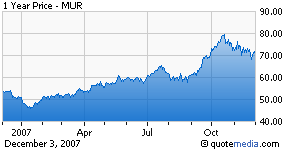Murphy Oil's An Attractive Acquisition Candidate
Inevitably, in about 5 years, both IOCs and NOCs will look into ways to replenish declining supplies, but it is improbable that their solutions will suffice. Oil is essential to everything we do, and currently, worldwide, companies are moving into increasingly technically challenging environments. As per a top executive at Exxon, the future of oil is in deep waters. Access to resources typically includes companies drilling in waters up to 3,300 feet, and some have drilled up to 9,800 feet. As per “The Oil Factor” by Stephen Leeb, oil is not coming back and once you burn it, you lose it. The combination of a world becoming fast industrialized and an increasing world population insures that supplies will not meet demand, and so it is necessary to look to the future to see how our energy sources will be used to maximize supply.
China has become very active in searching the globe for oil and gas, and acquiring companies to feed its hunger for energy. China is desperate for oil as more Chinese own cars and heat their homes, in addition to a simultaneous huge amount of infrastructure building to accommodate the growing population’s need for housing and increasing traffic. All this leads us to Murphy Oil.
Murphy (NYSE:MUR) is a relatively small company with 189 million shares outstanding, a P/E ratio of 21, and based on a forward year P/E of 18 and an EPS growth rate next year of 35.8%, a very attractive projected earnings growth [PEG] of 0.5. Currently comparing Murphy’s 2nd quarter 2006 to 2nd quarter 2007, the quarterly earnings growth year over year was 16% (that’s in comparison to Exxon Mobil Corp. (XOM), and BP PLC (BP) whose earnings growth rates are -1%, and -3%, respectively. Murphy’s worldwide locations include but are not limited to Mississippi, Canyon Green, Canyon Garden Banks, Viosca, Lloyd Ridge, deepwater Gulf of Mexico, Louisiana, and Alaska, in the U.S., offshore Newfoundland in Canada, Atlantic Margin west of the Shetland Islands in the United Kingdom, North Sea, Ecuador, Malaysia, and offshore blocks in the Republic of the Congo. Murphy’s operations of the coast of Thailand have great possibilities. Out of Murphy’s two segments of business, Exploration and Production (E&P) and Refining and Marketing (R&M), R&M shone during the second quarter of 2007. Compared to a net loss of $11.1 million in the second quarter of 2006, R& M segment produced $124.2 million during the second quarter of 2007. The E&P segment experienced lower sales in oil and gas, partially offset by higher pricing, producing $149 million in 2nd quarter net income, falling short of the $251 million in the same quarter last year. Murphy is presently giving a 4th quarter production guidance of 52 million cubic feet/day in gas and 84,400 barrels/day in oil. Murphy’s 3rd quarter 2007 guidance of a range of $0.80 to $0.92/share was beaten by actual results, as income was close to $200 million, yielding earnings per diluted share of $1.04.
Looking to the future, companies like NACCO and Headwaters stand to benefit from clean diesel technologies, and the process of liquefying coal, and the companies to benefit from the mass production of clean diesel engines are Cummings and Borg Warner. Murphy as a small company with many worldwide strategic locations is a prime takeover target either by a Chinese company or a larger oil and gas company here in the United States.

Disclosure: Author is long MUR.



